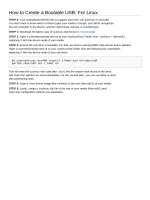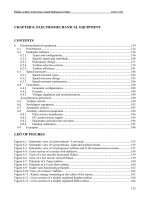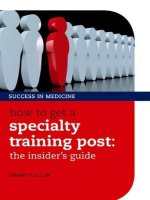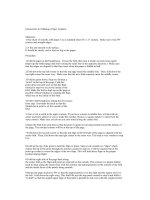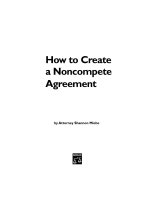how to create a great ecommerce content strategy
Bạn đang xem bản rút gọn của tài liệu. Xem và tải ngay bản đầy đủ của tài liệu tại đây (761 KB, 28 trang )
INTRODUCTORY
HOW TO CREATE A GREAT
ECOMMERCE CONTENT STRATEGY
A publication o
f
Learn more
about HubSpot’s all-in-one
inbound marketing software
at www.HubSpot.com
October 2011 edition
HOW TO CREATE A GREAT ECOMMERCE CONTENT STRATEGY
2
Share this eBook!
www.HubSpot.com
HOW TO CREATE A GREAT ECOMMERCE
CONTENT STRATEGY
By Randy Cronk
Freelance Marketing, Technology and Business Writer
@randycronk
Share this eBook!
HOW TO CREATE A GREAT ECOMMERCE CONTENT STRATEGY
3
TABLE OF CONTENTS
INTRODUCTION: THE VALUE OF A CONTENT STRATEGY 4
CHAPTER 1: GREAT CONTENT MATTERS 6
CHAPTER 2: FOUR CONTENT PRINCIPLES 9
CHAPTER 3: HOW CONTENT SELLS 14
CHAPTER 4: WRITE GREAT CONTENT 19
CHAPTER 5: CONTEXT DRIVES CONTENT 22
CONCLUSION: FINAL WORD ON CONTENT FOR ECOMMERCE 27
Share this eBook!
www.HubSpot.com
HOW TO CREATE A GREAT ECOMMERCE CONTENT STRATEGY
4
THE VALUE OF A CONTENT STRATEGY
Most of what people know about your
ecommerce business is what they read,
view or hear about you online — on your
website, on other sites in your industry, in
search engine results, and on social
networking sites. Most of that content you
control directly in the text, photos, videos,
and audio you publish yourself. Much of the
rest you control indirectly — by influencing
what others say in response to what you do
publish.
The fact that you have so much control over
a factor that largely determines your
success means you’d better know how to
control it. You’d better know content
strategy.
The sites consumers visit most and stay on longest are ones consumers find most
enjoyable and valuable. The sites where consumers buy the most are those with new
content that predisposes them to buy and keeps them coming back until they are
ready to buy. These sites understand key principles of content strategy. For example,
they get it that product value is not always self-
evident and that web visitors want useful
information, not just a sales pitch. They understand
that some shoppers shop because they like
shopping, not just buying, if they find a shopping
environment that engages them. These sites also
know how to create and leverage a unique brand
personality with content that differentiates and
excites.
Content is the universal
elixir for attracting atten-
tion, developing leads
and converting leads
into customers. But like
any tool, it only works if
you know how to use it
effectively
These sites are marketing; they’re not just selling.
Share this eBook!
www.HubSpot.com
HOW TO CREATE A GREAT ECOMMERCE CONTENT STRATEGY
5
Share this eBook!
www.HubSpot.com
Just because someone visits a site doesn’t mean they’re ready to buy — but they are
more likely to buy at some point than is someone who never visits the site. What
marketing does is bring more of those “warm” prospects to the site and builds
relationships with them. Marketing does this with content designed to attract both
people and search engines, to differentiate, to be liked, to be shared with friends and
colleagues and to convert prospects to leads to buyers.
How this happens largely depends on their context, such as where they sit in the
marketing funnel. Are they TOF (top-of-funnel = new prospect), MOF (middle-of-funnel
= sales lead being nurtured toward a purchase), or BOF (bottom-of-funnel = ready to
buy)? The higher in the sales funnel, generally the more educational and less “pitchy”
content should be — in terms of both information and calls to action (i.e., offers
you’re asking the visitor to accept as a result of having read your content). Other
“context drivers” are: average customer spend, product complexity, length of sales
cycle, and number of purchase influencers — all factors, by the way, that tend to be
higher for B2B.
Engaging content also shares some key attributes across contexts. For example, it is
relevant, keyword rich, consistent both in voice and publishing schedule and
abundant. It is not overly promotional nor does it copy other people’s content. It’s
fresh, valuable and authentic. And it reflects a clear and informed strategy for
reaching ecommerce success.
1
GREAT
CONTENT
MATTERS
HOW TO CREATE A GREAT ECOMMERCE CONTENT STRATEGY
7
IF THEY DON’T BUY YOUR CONTENT, THEY WON’T BUY YOUR
PRODUCT
Websites are a lot like movies, books, TV
shows and other forms of media. They don’t
succeed if they don’t hold people’s attention.
So one comment you’ll often hear from a
movie or book critic is one you might also hear
from a web reviewer — “this website has a lot
of content” or “that website doesn’t have a lot
of content.” What are they talking about? First,
what content consists of and what it is are two
different things. Content consists of text,
images, audio, and graphics — basically
whatever forms of expression people use to
communicate ideas. But as you know from personal experience sitting through a bad
movie — you can have a lot of words (or “action”) and still not have much content.
Content is both the ideas and the experience of reading, watching or hearing how
those ideas are presented. If content were just some ideas stung together, then
people would read plot summaries rather than go see actual movies. That’s not what
they do, of course, because that would be boring. But movies that are all about
presentation — e.g., big special effects with no plot — also get boring pretty fast.
People “get” great content — they get value from the ideas presented and they get
value from how the ideas are presented. It’s not great content, however, if someone
has to explain why people should get it. They just get it, automatically. The ideas are
inherently interesting, insightful, intriguing, helpful, enabling, informative or of value
in some other way. And the presentation is technically proficient — the author knows
how to tell a good story, write a good article, produce a good piece of video or
execute whatever particular form of content the content happens to be.
Ecommerce websites are not movies but the same principles apply. People won’t buy
your product if they don’t buy your content first. That’s not fair, of course. Like most
ecommerce sites, you are probably in the product (or service) business, not the
content business. It’s the product, not your content, that people are paying for. And
Share this eBook!
www.HubSpot.com
HOW TO CREATE A GREAT ECOMMERCE CONTENT STRATEGY
8
Share this eBook!
www.HubSpot.com
it’s the product, not your content, that people will be using long after they leave your
website. It’s also your product, not your content, that people will complain about if
something goes wrong later. In fact, the better your content, the more your content
skills will probably be ignored. On the other hand, the better your content, the more
your product will shine.
So you want a lot of great content — in both senses, a lot of really valuable ideas
conveyed with great presentation skills. Your content is everything on your website
that consumers know and experience about your product before it actually comes off
your site and into their hands. Your website content is also something you control
virtually 100%. You get to decide what words, images, audio clips, etc. go up on your
site and where. You control the layout, the descriptions, the links to other sites, the
offers, the calls to actions — in short, the entire experience. It’s all content! That is an
amazing opportunity because it means you have almost 100% control over how
people will respond to you, at least initially.
You do have other opportunities to influence, of course, as people try out or buy your
product and word spreads — so, yes, actual performance counts for a lot, as does
what other influential people in your industry say about you (including competitors).
But even here your website content has a major impact. For one thing, your website
is your first impression on the market, and first impressions are strongest. For
another, a lot of third-party commentary is a response to what you say first — which
means you get to help set the ground rules by which your product is judged. (At least
you should help set the ground rules if you’re doing content right.)
2
FOUR
CONTENT
PRINCIPLES
HOW TO CREATE A GREAT ECOMMERCE CONTENT STRATEGY
10
MAKING CONTENT ATTRACT, HOLD, AND MOVE CONSUMERS
TO BUY
Just as ecommerce websites are not
movies, they are also different from other
kinds of marketing websites, although they
share important traits with those as well.
Content can’t just be engaging, and it can’t
just promote products. It’s got to
:
1) Attract and hold the consumer’s
interest
2) Move the consumer from “yes, I’m
interested” to “yes, I want to buy,”
3) Make the actual sale.
That's a heavy load. The good news is there are some known ecommerce principles
that control how much success you have on all three fronts. Here are four of those
principles:
1. CONSUMERS WANT TO BE EDUCATED
Product value is usually not self-evident, espe-
cially in a B2B, or business-to-business, context.
So the first step in almost any product purchase
is usually research. Even if they expect to
ultimately buy in a store, consumers usually
head to the web first for product information
before walking out the door. (Ideally, of course,
they’ll also shop online once they visit your
website.) The web lets them conduct their
product research from the comfort of their own
home or office. They can cover a lot more
Share this eBook!
www.HubSpot.com
HOW TO CREATE A GREAT ECOMMERCE CONTENT STRATEGY
11
sources in a lot less time. They can often get information that’s more difficult to get
offline — information from articles, white papers, reviews and so forth. And, finally,
they know that online they won’t be dealing with pushy salespeople.
The fact that people come to your site in search of content is a huge advantage. It’s
not like you have to sell them on the idea of looking for product content in the first
place. Of course, we all know if the website fails to take advantage of this opportunity
— visitors quickly go elsewhere. But if you do meet that need, not only can you keep
visitors on your site during their first visit, you can keep them coming back for more
education until they are ready to buy. The way you keep them staying longer and
coming back is by continuing to feed their need for content.
Content consumers typically want includes information about:
• Price
• What value they get by paying a higher price
• What they lose or risks they take by buying at a lower price
• What features are more or less important and why (including those they
might not have previously considered)
• What other consumers and professional reviewers are saying
• How to use the product (perhaps in applications they might not have
previously considered)
• Issues surrounding the product, such as environmental impact or fair
trade
• How the product does what it does (especially important for B2B, where
technical specialists are heavily involved in the purchase decision)
Share this eBook!
www.HubSpot.com
HOW TO CREATE A GREAT ECOMMERCE CONTENT STRATEGY
12
2. CONSUMERS WANT A SHOPPING EXPERIENCE, NOT JUST A PRODUCT
Content not only feeds people’s informational need for data, it also feeds their
emotional need to shop. As discussed later, research
shows that women in particular
— but many men as well — like the experience of browsing, comparing prices,
fantasizing about what owning a particular item might be like, talking with other
customers, talking with vendors and doing all the other activities that fall under the
heading of shopping. Giving people more, and more varied, content is how you
replicate that physical in-store experience in an online virtual environment.
3. YOU MUST STAND OUT
The bad news is that the web has made it
very easy for competitors to speak to your
target customer. The good news is that
many of these websites look the same.
Content is therefore key for creating a
specific brand personality — for being
known for selling into a particular market
niche and in a particular self-identifying
manner that people remember. This is
important for attracting both people and
search engines. If your content is brief,
generic and uninformative, why should anyone “hang around”? If, on the other hand,
the site becomes known as an authority; if the content is presented in a unique and
memorable way, then more customers will come and rate your website higher. And so
will search engines. If your site’s content is similar to that on most other sites in your
market, why should search engines rank it any higher? If, however, the content is
different, that difference (if positive) will register and you’ll rank higher in search
results.
4. SEO IS CONTENT BASED
To rank higher, your content can’t just be different. It must present more keywords
that better support your particular brand and market niche. That is how you become
a bigger SEO (search engine optimization) target. Not only must the content be more
Share this eBook!
www.HubSpot.com
HOW TO CREATE A GREAT ECOMMERCE CONTENT STRATEGY
13
Share this eBook!
www.HubSpot.com
finely tuned on both an informational and presentation level, there must simply be
more of it. That starts with knowing which keywords (the top 10 or so) you want each
page of your website to rank highly on. That usually means striking a balance
between keywords that are highly popular in your industry (but not necessarily
differentiating) and keywords that are more specific to your niche (but less popular).
More popular keywords will attract more searches in general, while more
differentiating keywords will do a better job of pulling visitors looking for your specific
kind of offering.
These four principles are the “what” of ecommerce content. But the “how to” also
matters. Just providing lots of keyword-rich product information in a style that attracts
attention is not enough. Engagement for the sake of engagement doesn’t sell. Any
good book does that. And even though any good ecommerce website performs a
public service by educating buyers, ultimately that is not its objective either. How do
you go from publishing an engaging, information-rich site, to one that actually sells
product?
3
HOW
CONTENT
SELLS
HOW TO CREATE A GREAT ECOMMERCE CONTENT STRATEGY
15
5 ATTRIBUTES THAT DIFFERENTIATE MARKETING CONTENT
Selling is more than just marketing, of course. But selling is also more than just
selling. If all your content does is pitch features and benefits and tries to close sales,
then the only customers you’ll likely sell to are those who are: 1) already
knowledgeable about the category, 2) ready to buy, and 3) already on your site.
This is obviously a relatively small group. Of course, this is also a very important
group, and one you definitely want to sell to at every opportunity. If someone is ready
to buy, you don’t send them an offer for a webinar instead. You make the “buy”
button easy to see, the purchase instructions easy to follow, and the steps to
purchase as few as possible.
As for the vast majority of
potential customers — they’re
just like customers in a store.
They may not be ready to buy
at that very instant, but the
reason they are in the store
(or on your site) in the first
place is because they are
potentially interested in
buying. Most likely they are
open to the possibility.
Notice, for example, the
different impact blog content
has in the different phases of the purchase decision (Figure 1), even though a
relative small percentage of that impact occurs at the final purchase itself. If you only
give consumers a non-stop stream of sales pitches and nothing more, you will
probably turn them off. They want to know more, and they want you (or one of your
competitors) to engage them. In other words, you have to market to them — and
that’s what most of your content is about: getting these virtual tire-kickers to the
point of purchase.
Five attributes that differentiate marketing content, therefore, are:
Share this eBook!
www.HubSpot.com
HOW TO CREATE A GREAT ECOMMERCE CONTENT STRATEGY
16
1. IT DIFFERENTIATES
One way to make your product stand out is by making you stand out. In terms of
presentation content, write in your own voice; don’t try to copy someone else’s style
(or let a ghostwriter substitute his or her voice for yours). Write from your own
experience with your own insights.
A great example of a differentiating voice is the couponing site, groupon.com
, which
uses comedy writers to pen the various deals, such as a $20 coupon worth a $40
meal at a local restaurant. As critics at the New York Times
, have noted, the humor is
an effective device for setting the site apart in what is increasingly a crowded market
of me-too groupon imitators.
People tend to be attracted to other people, and not so much to objects, which
means coming across like a human being makes you more relatable. In terms of
informational content, present, or better yet, demonstrate what makes your product
different, through videos or customer testimonials. Chances are that you got into your
current business because you genuinely felt that you have something to contribute
that no one else does — innovative technology, a better business model, a unique
blend of services — whatever. Start there.
2. IT IS SHARED
Marketing content should be “sharable” — i.e., it is content people will want to share
and is in a form that is easy to share — videos, blogs and how-to articles, for example.
Videos attract search engines; they are easy for people to embed inside their own
websites or blogs; and they are easy to link to. They can also be more visually
interesting than just text — which makes people want to include them in their sites.
Blogs are another good example of highly sharable content since they invite
comments and are often linked to by other bloggers who wish to join in the
conversation. The key here is to blog on subjects other people want to talk about —
like themselves (rather than you) or controversial issues. How-to topics, whether in
blogs or your main site, are also highly sharable since people use them as a
resource. How-to content works best, again, when it focuses on the problem getting
solved rather than on you or your product.
Share this eBook!
www.HubSpot.com
HOW TO CREATE A GREAT ECOMMERCE CONTENT STRATEGY
17
One reason you want to share more with customers is that you want customers to
feel comfortable returning the favor — sharing more with you — especially when it
comes to information that will help you market to them in the future. That’s
information like their email address, product likes and dislikes, and demographic
information (age, occupation, and so on).
3. IT IS LIKED
Being controversial and being liked may seem at cross-purposes. On the other hand,
no one really likes and, worst, rarely trusts someone who agrees with everyone else
and never expresses an individual opinion. Having an opinion means you're a player
in your industry and someone to respect. Again, as a start for writing content, go back
to what got you into your business. Bring that passion into your content. Speak to
other people’s needs, annoyances, and aspirations. Show that you have something
real to contribute that will improve their lives. People will like you for it.
4. IT BUILDS RELATIONSHIPS
The first three marketing content
“how-tos” just listed —
differentiating, sharing, and being
liked — all contribute to the fourth,
which is to build relationships.
Relationships have qualities that
one-off transactions don’t —
qualities that keep customers
coming back and spending more
with less prompting. Relationships
are sustainable over time. They encourage information sharing. They foster loyalty.
And they reduce marketing and transaction costs. But, again, consumers have
relationships with people and businesses, not with products. So even if consumers
can’t know you personally — your content has to have a personality (probably yours)
and it has to speak to people rather than simply about them. Use words like “you”
when speaking about a customer’s need, rather than “they.” Instead of using
business cases to make a point, write success stories featuring heroes with whom
your customers will identify. Stories have a setup, a conflict and a resolution — not
Share this eBook!
www.HubSpot.com
HOW TO CREATE A GREAT ECOMMERCE CONTENT STRATEGY
18
Share this eBook!
www.HubSpot.com
simply a “situation” and “results.” Failure and success have real-life consequences —
talk about them. The more empathy your content shows, the more connections you
make between you and your audience, and the stronger the relationships.
5. IT PREDISPOSES TO BUY
Give the consumer reasons to act, rather than just consume content they passively
enjoy, find valuable and can relate to. That requires calls to action — offers for more
content (if they’re not yet ready to buy) and offers to buy (if they are ready). Always
giving consumers the “buy option” on each web page means you don’t have to read
their minds to know when they will likely be ready to buy. And always putting an
option for more content (e.g., a white paper, webinar, etc.) prods them out of their
passive state so that taking some action doesn’t seem like a foreign concept. People
who are already interacting with you when they’re not buying have less of a mental
barrier to cross when they do buy.
Calls to action are constructed differently than other kinds of content. They are what
your high school English teacher would call imperatives, with words like “buy now,”
and “click here to download.” They include rewards for taking immediate action, like
the product’s benefits, solutions to problems, technical knowledge, a discount, free
add-ons (like a service contract) and so on. These rewards come in various
“packages” — such as a white paper, webinar, free trial, and of course the actual
product you ultimately are looking to sell — each of which calls for a different level of
customer commitment.
When and where you employ a specific call to action is also important. And so is
knowing when to apply the other techniques and principles just discussed. The when
and where part of content strategy is called your context.
4
WRITE
GREAT
CONTENT
HOW TO CREATE A GREAT ECOMMERCE CONTENT STRATEGY
20
Share this eBook!
www.HubSpot.com
HOW TO WRITE ENGAGING CONTENT
Just like some authors always seem to write best
sellers, some writing techniques always seem to
produce more engaging marketing content almost
regardless of what product or audience is being s
Here are a few of those techniques:
old.
MIX IT UP
As this HubSpot blog article on blog writing suggests,
most readers don’t like a steady diet of the same
thing all the time — and not just for blogs. Mixing it
up means giving readers both shorter and longer
pieces of content, case studies as well as tutorials,
sales pitches as well as articles designed to
educate, humor as well as formal presentations, and
so on.
BE CONSISTENT
You can be mix it up and still maintain a consistent voice and brand personality. In
fact, you must if you want a brand people will remember and remember as being
different from your competitors. That includes being consistent in your blogging
schedule so people know when to expect your content, and look for it.
MAKE IT TOPICAL
Write what people in your industry care about now. Make yourself look relevant by
referencing current trends and issues. If people are already interested in these
topics, they will probably be interested in you if you have something relevant to say.
HOW TO CREATE A GREAT ECOMMERCE CONTENT STRATEGY
21
Share this eBook!
www.HubSpot.com
BE PROLIFIC
One of the most effective content strategies is also the simplest — publish a lot of
content. The more content you have — and the more information (and keyword) rich
content you have — the greater the opportunity for both people and search engines to
spend time on your site.
WRITE TO A PERSONA
Create in your mind (and on-screen) a profile of your target customer — shopper,
buyer, business purchaser, consumer, etc. — and serve the content needs of that
profile for both presentation style and information. What are they comfortable with?
What do they need to know? Are they more “how-to” oriented, more “how’s-it-work”
oriented or more “what’s the ROI?” oriented? Balance your content accordingly.
5
CONTEXT
DRIVES
CONTENT
HOW TO CREATE A GREAT ECOMMERCE CONTENT STRATEGY
23
Share this eBook!
www.HubSpot.com
THE 3 BIGGEST CONTEXT VARIABLES
If content drives customer and search engine behavior, it is context that drives
content. Context is all the variables that impact your choice of content at any given
moment. Three of the biggest context variables are:
• Whether your business is B2B or B2C (business to consumer)
• Where your customer sits in the sales funnel
• Whether your customer is more of a shopper or buyer
1. B2B OR B2C?
Content targeted at business buyers is
typically “richer” than content for
consumers — meaning that there is
more information on each web page
and there are usually more web pages,
blog articles, white papers, recorded
webinars, and so on. There is simply
more to say that is relevant to the
buying decision. Business products a
services often are more technical and
have to be integrated with the existi
products and processes of the buyer’s
business. That’s not to say that all
consumer markets don’t require mo
content — vehicles being a good
example of one that does. And, as
mentioned earlier, content is an effective way to create differentiation, which is often
harder to demonstrate in a consumer category. Even so, consumers typically have
less of an appetite for the in-depth technical content that business buyers often seek
and which B2B sites can leverage for sustaining ongoing involvement with the
customer.
nd
ng
re
HOW TO CREATE A GREAT ECOMMERCE CONTENT STRATEGY
24
Share this eBook!
www.HubSpot.com
B2B sites need that longer customer involvement, due to another B2B/B2C
difference, which is that B2B products and services typically have a longer sales
cycle. That’s partly due to the complexity of the product and the complexity of
integrating it into the business. And it’s due to its higher cost compared to most
consumer products. But it’s also because of another difference between B2B and
B2C markets, which is that multiple levels in the organization from different
departments (e.g., IT and manufacturing) must approve the purchase. So not only do
you need more content going into more depth over a longer time period, you also
need to speak different vernaculars — IT speak, attorney speak, production speak
and so on. That’s difficult to do in any single content piece, such as a web page,
white paper or video, and may require what might be considered multiple “channels,”
each with its own set of tailored audience-specific content items.
2. SALES FUNNEL POSITION
The journey from browser to buyer is
often described as a sales cycle or
sales funnel. The funnel metaphor is
more apt because the number of top-
of-funnel (TOF) browsers on your site is
almost always less than middle-of-
funnel (MOF) active leads and is much
less than bottom-of-funnel (BOF)
buyers. Each of the three positions —
TOF, MOF and BOF — also requires
different kind of content to move that
customer further down the funnel. B
content is obviously more about
features and benefits with strong buy
calls to action. Rewards — e.g., a 30-
day free trial — can also be bigger
because the customer has shown sustained interest and the investment risk is lower.
TOF content would be much more educational. Calls to action would be more content
oriented — e.g., “download our free white paper” — since both the need for education
is greater and the risk of them just walking away is higher. “MOF” funnel sales leads
OF
HOW TO CREATE A GREAT ECOMMERCE CONTENT STRATEGY
25
must be nurtured. These folks have
demonstrated interest, probably by
accepting (e.g., “converting on”)
previous low-risk educational content
offers. Nurturing content is content
that is: 1) consistent; and 2)
addresses specific questions and
concerns — perhaps in response to
shared information or behavior
tracking (such as web pages visited).
E-newsletters are great nurturing tools
if they offer timely relevant content on
a consistent on-going schedule.
What Not
To Do
As with any strategy, when it comes to con-
tent, formulating strategy often requires un-
derstanding what not to do as much as
learning what you should do — for example:
Don’t borrow other people’s content. This
especially applies to product descriptions
where the temptation is to simply copy and
paste descriptions from suppliers’ sites. Bor-
rowed text adds nothing to your SEO ranking
and makes you look “me-to” in the eyes of
consumers.
Don’t talk to (or about) your competitors.
This applies to marketing content in general,
not just web marketing or ecommerce. Talk-
ing about your customers raises their profile
and can make you look defensive (i.e., fol-
lower) rather than a leader. You should be
setting the tone and the defining the field on
which competitors play. You also don’t want
to give your competitors SEO credit by refer-
encing (or linking to!) their sites.
Don’t be too promotional. Content that’s all
about “me” and “how great I am” tends to
turn people off. Stick to talking about why
certain techniques or innovations work bet-
ter than others. People expect you to list fea-
tures and benefits — i.e., reasons to buy — on
a site whose purpose they know is to sell
them something. But cast those features
and benefits more as value to the customer
than as evidence of how amazing you are.
3. SHOPPERS OR BUYERS?
As discussed earlier, some people like
to shop as much for recreation as for
acquiring a product or service, while
others see shopping more as a means
to an end. Research shows that
women tend to fall more in the first
category (but not always) and men in
the second (but, again, not always).
“Shopper” content indulges people’s
need to browse, learn and interact
(such as with forums, blogs and
Tweets). “Buyer” content uses calls to
action and places these calls where
they are easy to find.
Then there are sites, like car sites,
that draw both shoppers and buyers.
The key here is to indulge those who
like to shop with lots of content and
Share this eBook!
www.HubSpot.com




